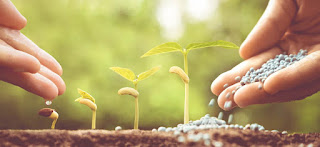e-Agriculture Potentials
 |
| Farmer calling an IVR system for information |
Farming in the 21st Century has become complex and competitive. The average farmer now sees farming as a business and not just a way of planting to feed himself and the family. It has become increasingly important for farmers to adopt Global Good Agricultural Practices (GAPS) and Good Handling Practices (GHP) in order to compete on the global market.
Implementing GAP in agriculture should not be considered as an end in
itself but should be followed up with regular training and adoption in which
the producers are trained to understand the economics behind efforts Good
Agricultural Practices. (Agric In Ghana, 2014)
With resource constraints and scattered geographical location of farms
and farmers in developing economies, Information technology/ systems offers
affordable and reliable means of reaching and disseminating information and
conducting trainings remotely.
e-Agriculture goes beyond technology, to
promoting the integration of technology with multimedia, knowledge and culture,
with the aim of improving communication and learning processes between various
actors in agriculture locally, regionally and worldwide. (Dogo, 2009)
The international context in which the Information
Technology (IT) applications for e-agriculture is modelled, requires
increasing manpower development and training that is predicated on
progress in telecommunications and information technology. (Dogo, 2009) thus increasing the
opportunity for tech savvy individuals and professionals to be engaged in
developing these applications while reducing the issue of unemployment in the
developing economies.
e-Agriculture requires an increase in the technical
capacities required of farm managers, pest management consultants,
plant pathologists, commodity brokers, agriculture education teachers,
extension agents, quality control inspectors, timber brokers, food industry
managers, foresters, breed organisations, field representatives, range
managers, government inspectors, conservation scientists, plant engineers, farm
crop advisers, animal health researchers, wildlife officers, aquaculturists,
and land management consultants. (Essiet, 2010)
The development and implementation of precision
agriculture or site-specific farming has been made possible by combining the
Global Positioning System (GPS) and geographic information systems (GIS). These
technologies enable the coupling of real-time data collection with accurate
position information, leading to the efficient manipulation and analysis of
large amounts of geospatial data. GPS-based applications in precision farming
are being used for farm planning, field mapping, soil sampling, tractor
guidance, crop scouting, variable rate applications, and yield mapping. GPS
allows farmers to work during low visibility field conditions such as rain,
dust, fog, and darkness. (Chauhan, n.d.)
References
Agric In Ghana, 2014. AgricInGhana.
[Online]
Available at: http://agricinghana.com/2014/12/05/good-agricultural-practices-gap-in-ghana/
[Accessed 7 June 2018].
Available at: http://agricinghana.com/2014/12/05/good-agricultural-practices-gap-in-ghana/
[Accessed 7 June 2018].
Chauhan, R. M., n.d. Advantages and Challeging in E
Agriculture. Oriental Journal of Computer Science and Technology, 8(3).
Dogo, H. A., 2009. AllAfrica. [Online]
Available at: http://allafrica.com/stories/200909180439.html
[Accessed 08 June 2018].
Available at: http://allafrica.com/stories/200909180439.html
[Accessed 08 June 2018].
Essiet, D., 2010. Exploring job opportunities in
e-agric. [Online]
Available at: http://www.e-agriculture.org/news/exploring-job-opportunities-e-agric
[Accessed 8 June 2018].
Available at: http://www.e-agriculture.org/news/exploring-job-opportunities-e-agric
[Accessed 8 June 2018].


Comments
Post a Comment